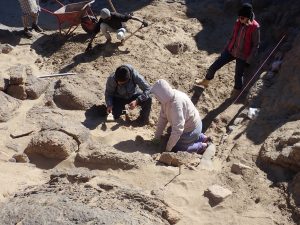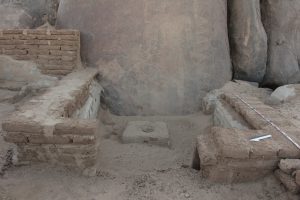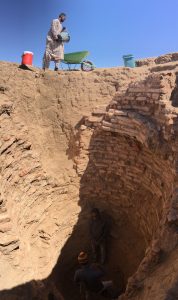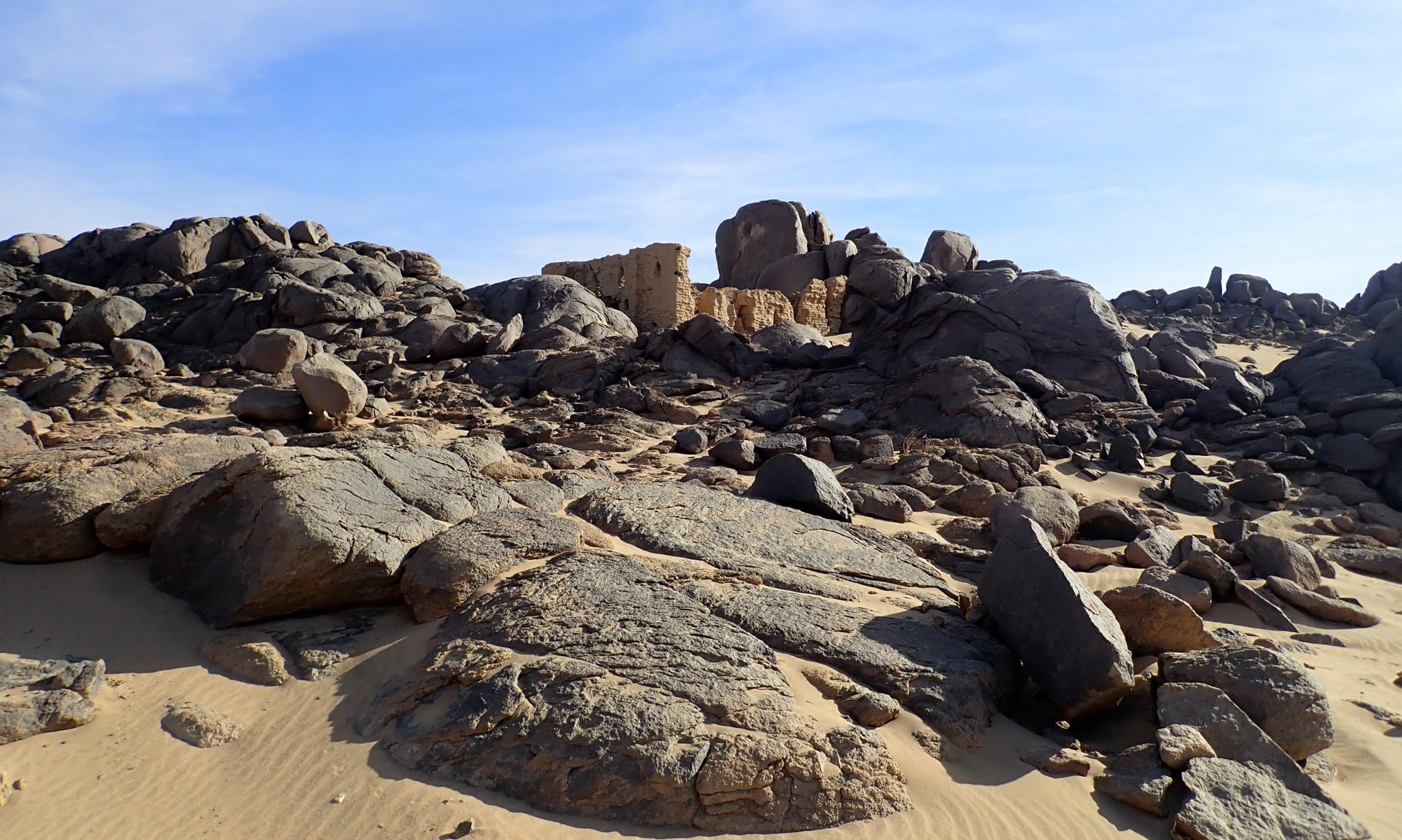From the beginning of January till early March our second season took place, in which a number of tasks could be realised. First of all excavation work started around the church. Digging inside had to wait, since the walls of the building were in need of consolidation. This meant that while archaeologists were working around the building, restorers and local builders were active inside.
The church – archaeological research
Excavations were concentrated on the areas South, West, and North of the church. Large deposits of wind-blown sand were removed, under which accumulations of collapsed material from walls and vaults was encountered. Large quantities of pottery were found among the deposits surrounding the church. A large quantity of pottery was collected, consisting of a wide variety of wares from medieval period. The material included transport, storage, cooking, and tablewares, an indication that for a considerable period many more activities than just liturgical services were taking place at the site.

A close examination of the walls of the church showed that there were at least two building phases. The western wall consists of two layers. The outer one of these has three windows, of which one was blocked when the inner layer was constructed, indicating that the outer layer antedates the inner one. In the southern wall one of the orinigal windows was blocked when the walls between the southern pastoforion and the southern aisle were constructed. This leads to the preliminary assumption that the church consists of and outer shell of N, S, and W walls that represent the first building phase, while the inner structure was built later. The inner walls show the clear remains of vaults and the arches that once supported the central dome. This structure of a domed and vaulted cross-in-square church is typical for Nubian architecture of the 10th century and later (Adams 2009, 277 sqq. type 4). This could mean that the first version of the building dates back to a much earlier period (possibly 7th century), and may have consisted of a church of the basilical type with flat roofs, supported by beams. The presence of early pottery in the deposits surrounding the church would support this assumption.
Within the building hardly any excavation work has been done, except for collecting pottery at the surface and removing windblown sand in the eastern areas in order to have better access to the walls there. This was necessary in order to consolidate the plaster and remains of wall paintings in the sanctuary and the northern pastoforion. During this work we gained some more insight in the decoration of the sanctuary. On either side of the rock drawing of the so-called ‘Good Shepherd’ there are six pair of feet and we should assume that these belong to the twelve apostles, so that the conclusion can be that the central figure was either re-interpreted as a depiction of Christ or that a legendary pre-Christian ruler was ‘Christianised’ and put in the company of the apostles. Further study will be indispensible here.

The Well (FAR052)
 At the bottom of Wadi Farja, at a distance of approximately 260 meters W of the church a concentration of red brick was visible at the surface, apparently the result of illegal digging. The decision was taken to excavate here and there turned out to be shaft lined with red brick, of approx. 2.60 m in diameter. Its depth was followed down to six meters. No significant pottery was found in and around this feature, which was apparently a well. Dating of the well remains uncertain.
At the bottom of Wadi Farja, at a distance of approximately 260 meters W of the church a concentration of red brick was visible at the surface, apparently the result of illegal digging. The decision was taken to excavate here and there turned out to be shaft lined with red brick, of approx. 2.60 m in diameter. Its depth was followed down to six meters. No significant pottery was found in and around this feature, which was apparently a well. Dating of the well remains uncertain.
Conservation and protection work
One of the main goals of this season was safeguarding the building, stopping deterioration by erosion by wind and rain and protecting the building from further damage by visitors. One of the first measures that were taken was the reinforcement and partial reconstruction of the adobe walls. Mr. Khaled Ibrahim, a local builder from the village of Diffinkur, was responsible for this work. Together with two helpers he manufactured several hundred of mudbricks of a size identical to those used in the church. A number of walls, especially the outer western and southern walls, were reinforced from the sides and layers of bricks were added at the top. The final goal will be to create a concrete shelter over the building, but as a temporary protective measure a roof was built that is supported by mudbrick pillars and that consists of an iron frame on which a traditional roof of palmleaf cores and mud rests.
Preliminary survey
In accordance with the planning of the project a preliminary reconaissance survey of the region surrounding the church that is within the concession as agreed with NCAM has been conducted. This concerns in the first place Wadi Farja, the main wadi, running south of the church. There was recorded a number of sites that had been found here during previous season, some partially included in the survey report of Ali Osman and David Edwards (Osman and Edwards 2012). In identifying these sites and features number were given according to the system initiated by Ali Osman and Edwards. Thus, ten new numbers, FAR052 – FAR062. The other area where preliminary survey was conducted and where sites and features were added to the list of Ali Osman and Edwards is the village of Miseeda and adjacent areas. Surface material (pottery, flint tools) was collected at a number of sites, such as the hilltop settlement in Miseeda (MAS020). In and around the village of Miseeda five additional sites were registered (MAS042 – MAS046).
Ethnographic research
Between 8 and 15 February an ethnographic research was carried out by our team member Maciej Kurcz. The research was focused in the following villages: Miseeda, Gumara, Barja, Ogjinoon. The works were preliminary and initial in character. The main focus of fieldwork this year was to find to investigate the social structure, cultural landscape and diversity of customs and traditions. Besides that what are the relations between the people and antiquities and what are the discursive practices that they revealed. In accordance with the “nets and anchors” approach we started with familiarisation with the study community. As a result a group of key informants were selected for a further ethnographic investigation. 20 interviews were carried out and a number of scientific observations. The obtained material reveals narratives of beliefs in jinn, haunted places, myth of gold and old Mahas customs connected with family festivals and the Nile.
